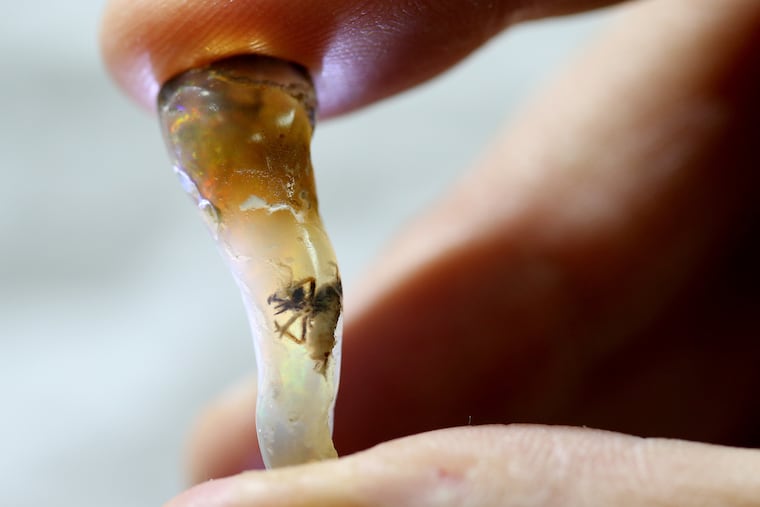Insect trapped in precious gem is mystery for Bucks County dealer, scientists
Scientists say they've never seen anything like it.

The Jurassic Park series was inspired by the real-life discovery of ancient insects trapped in deposits of amber.
A Bucks County gem dealer recently acquired a far more unusual specimen: an insect trapped inside a precious opal.
Scientists say they have never seen anything like it. And they are not sure how the stone, found on the Indonesian island of Java, could have formed while the insect remained intact. No one can even say what kind of insect it is, though it is presumed to be many millions of years old.
In the meantime, owner Brian Berger is drawing more buzz than a swarm of six-legged creatures.
Berger purchased the stone from another dealer in 2018 for a price he declined to disclose. He blogged about it in January for the Entomological Society of America, and the post has been shared more than 5,500 times on Facebook. National Geographic and Smithsonian.com have since come calling.
A longtime gemologist in the Philadelphia area, Berger knows his precious stones, and he knew this was a rare find. But he wants help in identifying the insect and determining how it might have gotten there.
“I’ve gotten 100 emails from different entomologists,” he said. “I’m trying to figure out who the right people to do the job are.”
One scientist in Germany has offered to create a high-tech 3D scan of the specimen so that the insect’s body can be reproduced in a larger size for study.
That is a reasonable approach, said Jon Gelhaus, curator of entomology at the Academy of Natural Sciences of Drexel University. After looking at high-resolution photos of the object, Gelhaus said much more detail was needed to make a proper identification. Some sort of beetle or ant, perhaps?
“It certainly looks insect-like,” he said. “It’s an oddity.”
George Poinar Jr., the biologist whose work on amber-encased insects inspired Jurassic Park creator Michael Crichton, also was hesitant to say much.
“At this stage, there is not much to say other than it is very interesting,” said Poinar, who holds a courtesy faculty position at Oregon State University.
The premise of Jurassic Park was that scientists could breed dinosaurs by extracting dinosaur DNA from mosquitoes that had bitten them millions of years ago. That idea is still science fiction, as few mosquitoes have been found in amber deposits from that era, and any dinosaur DNA inside is likely to have degraded.
Still, amber does a great job of preserving the bodies of insects. But opal?
Opal can form in two ways, though some of the details are not fully understood, said Peter J. Heaney, a professor in the geosciences department of Pennsylvania State University.
One occurs when cavity in a rock formation becomes filled with water that is enriched with a substance called silica — a compound of silicon and oxygen. The silica can form microscopic spheres that settle to the bottom in an orderly pattern.
“They will actually drop like marbles down to the bottom of the cavity,” Heaney said.
Over time, most of the water evaporates, and somehow the matrix of spheres solidifies, though that part of the process is not well understood, he said.
In one of nature’s eye-pleasing coincidences, the spheres measure several hundred nanometers across — in the same range as the wavelengths of visible light. Depending at what angle a stone is held relative to a light source, the spheres can interfere with the light to produce an array of colors.
“You see this kind of rainbow effect, where you might get reds appearing at one angle, and greens appearing at another angle,” the Penn State scientist said.
Depending on such factors as the patterns of color, size. and brightness, the stones can range in value from less than $100 to many thousands of dollars.
Opals also can be formed through a process called opalization, which involves the same silica-in-water solution. The dissolved silica can seep into another material such as bone, wood, or seashell. The host material can then decay or otherwise be replaced over time by silica spheres, leaving behind an opal.
Without a detailed analysis, it is hard to say which type of opal formation preserved Berger’s insect, scientists say.
A key requirement would be an environment low in oxygen, said Katy Estes-Smargiassi, manager of the invertebrate paleontology collection at the Academy of Natural Sciences. If the insect became trapped in a rock cavity full of water, it might decay unless oxygen levels were sufficiently low.
But if the opal was formed by the substitution method, then the insect’s body may itself have been opalized — replaced by silica spheres, she said. In that case, the insect would have to be trapped in some kind of substance (such as the amber in Jurassic Park), and somehow the whole thing turned into an opal over millions of years, though that possibility seems less likely than the cavity method, Estes-Smargiassi said.
“There’s no way of knowing any of this for sure without seeing the fossil in person and being able to analyze it chemically,” she said.
Upon seeing photos of Berger’s specimen, Heaney’s first reaction was to wonder if it was synthetic, as opals can be made in a lab.
Not to worry, Berger said. The stone has been certified as genuine by the Gemological Institute of America.
It may not be as strange as the fictional dinosaurs of Jurassic Park. But for now, the opal seems to be one of a kind.